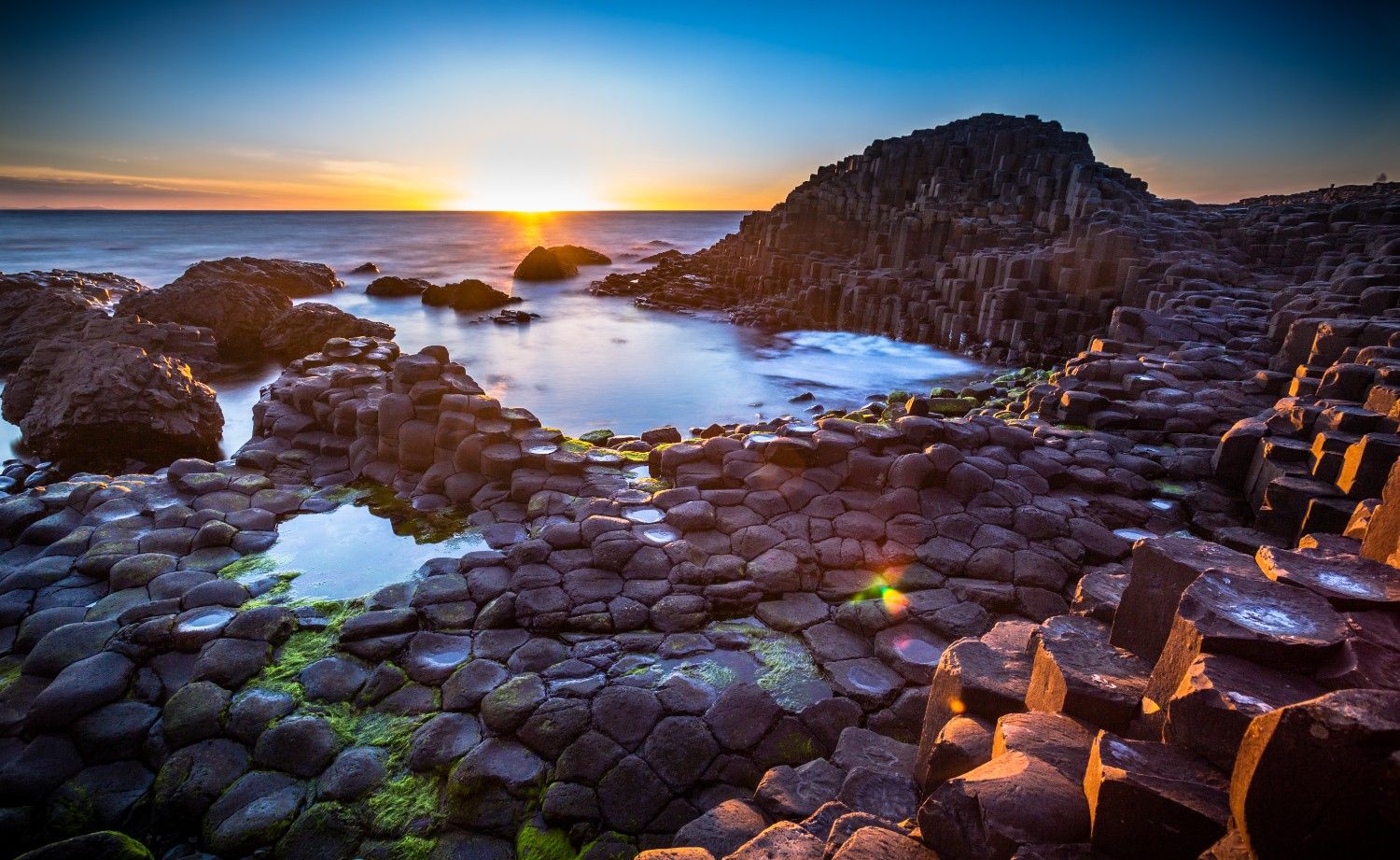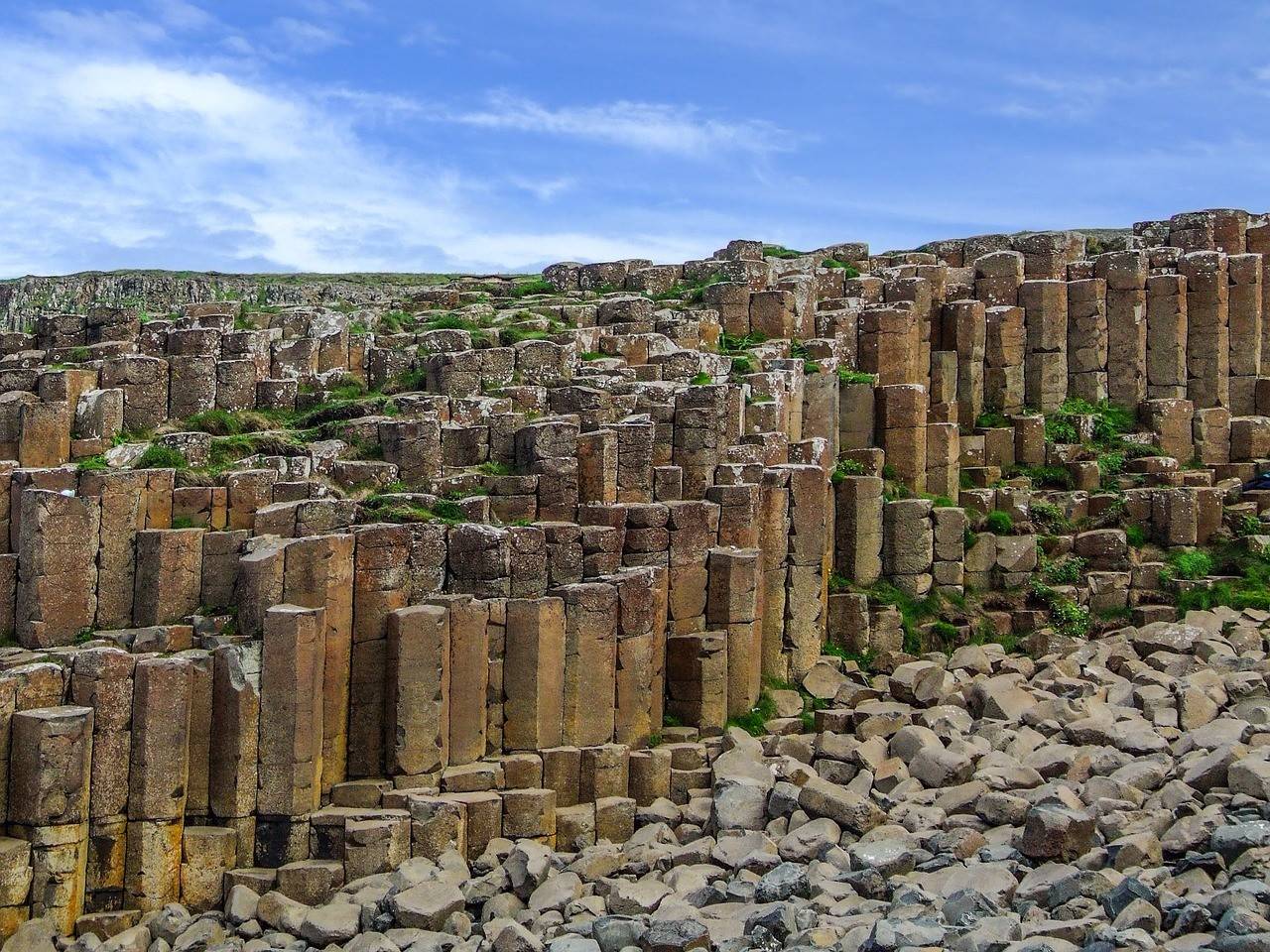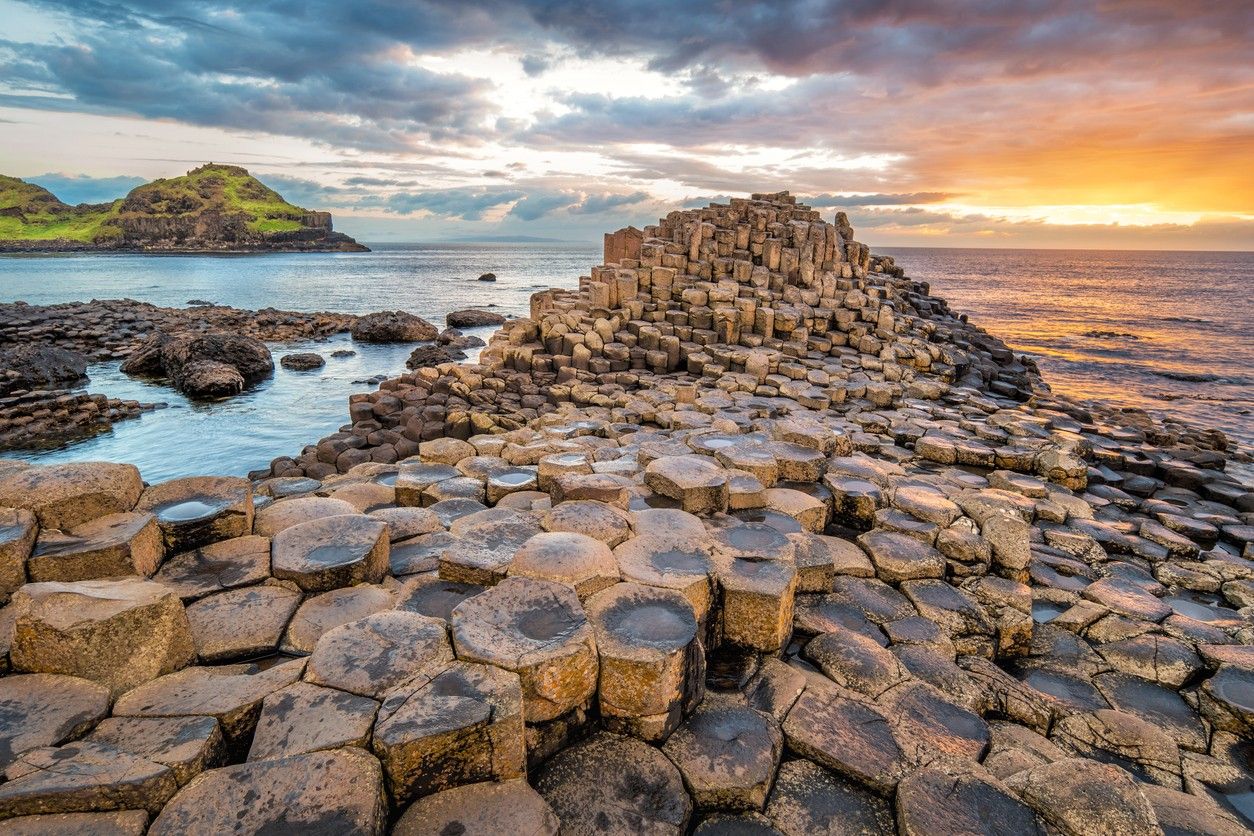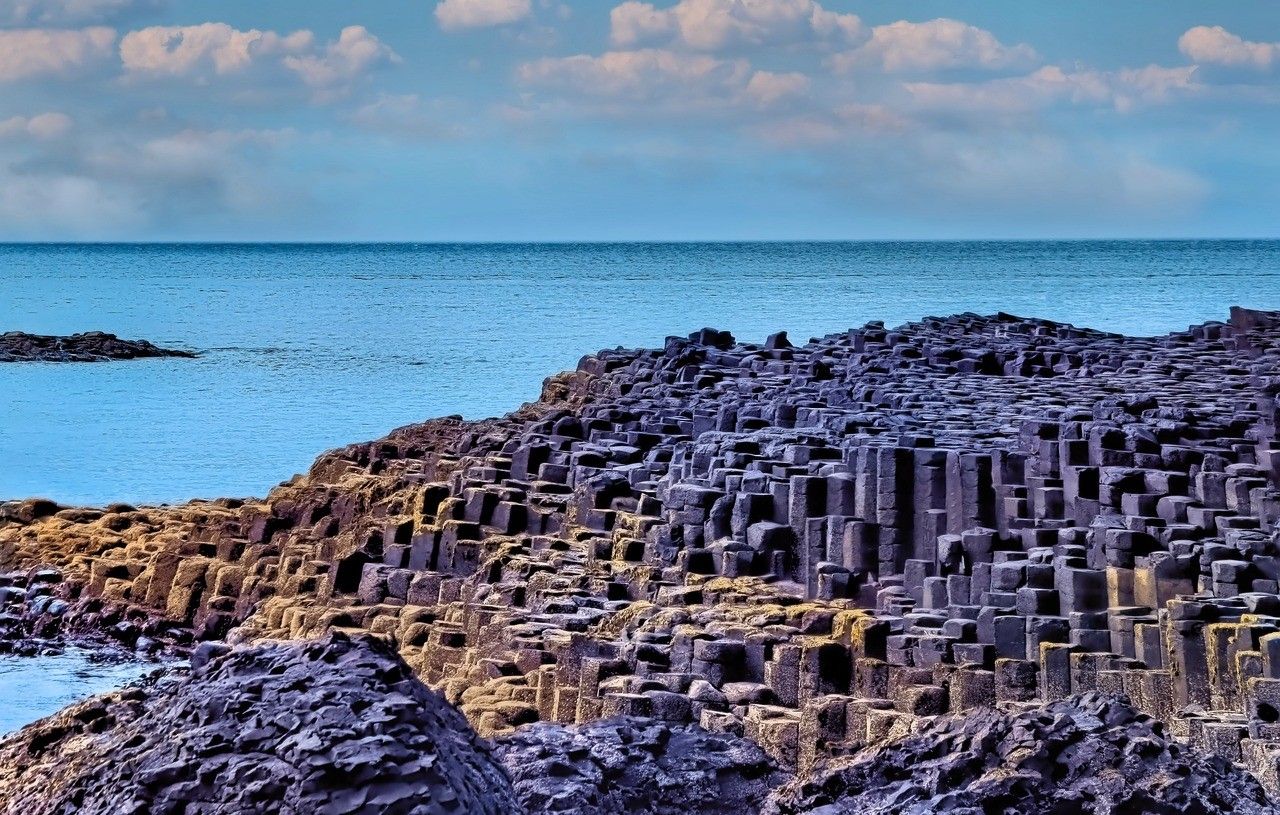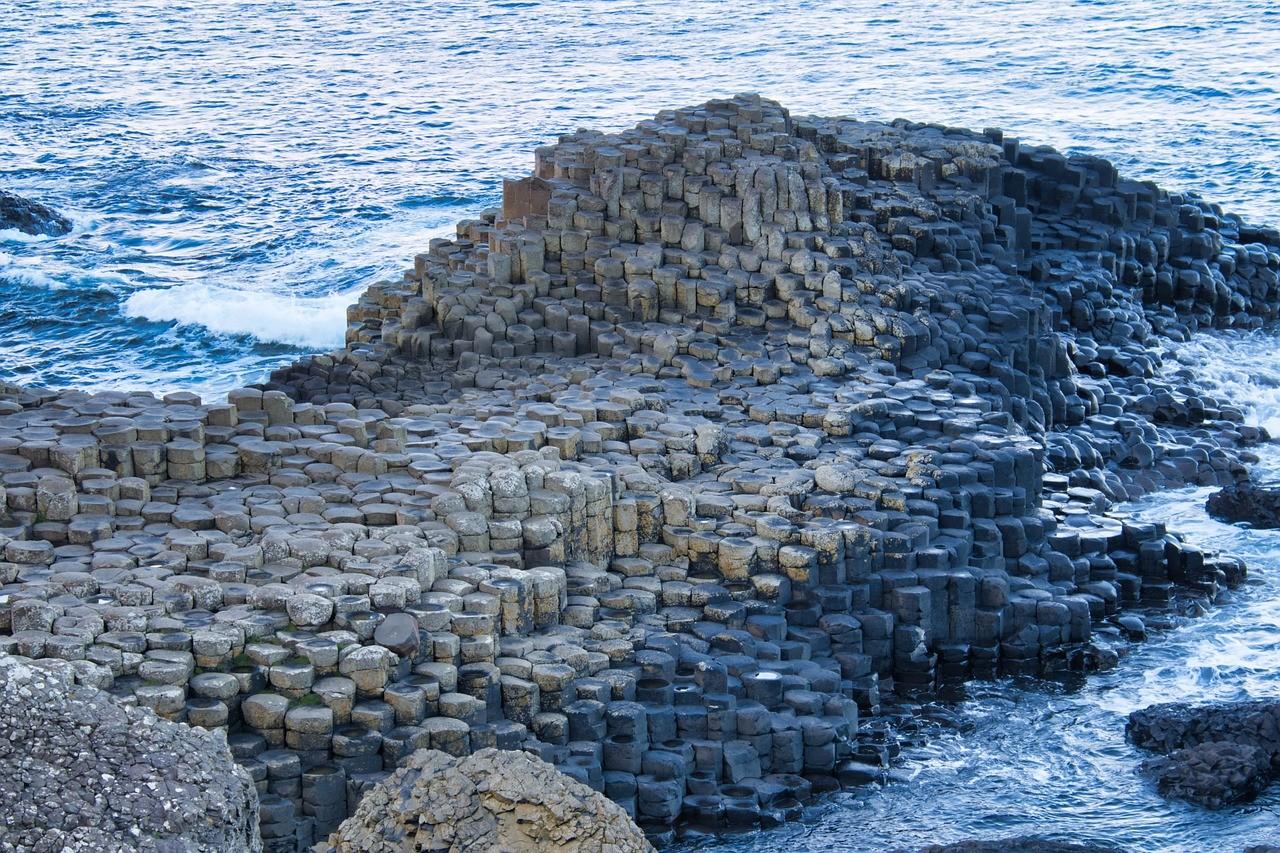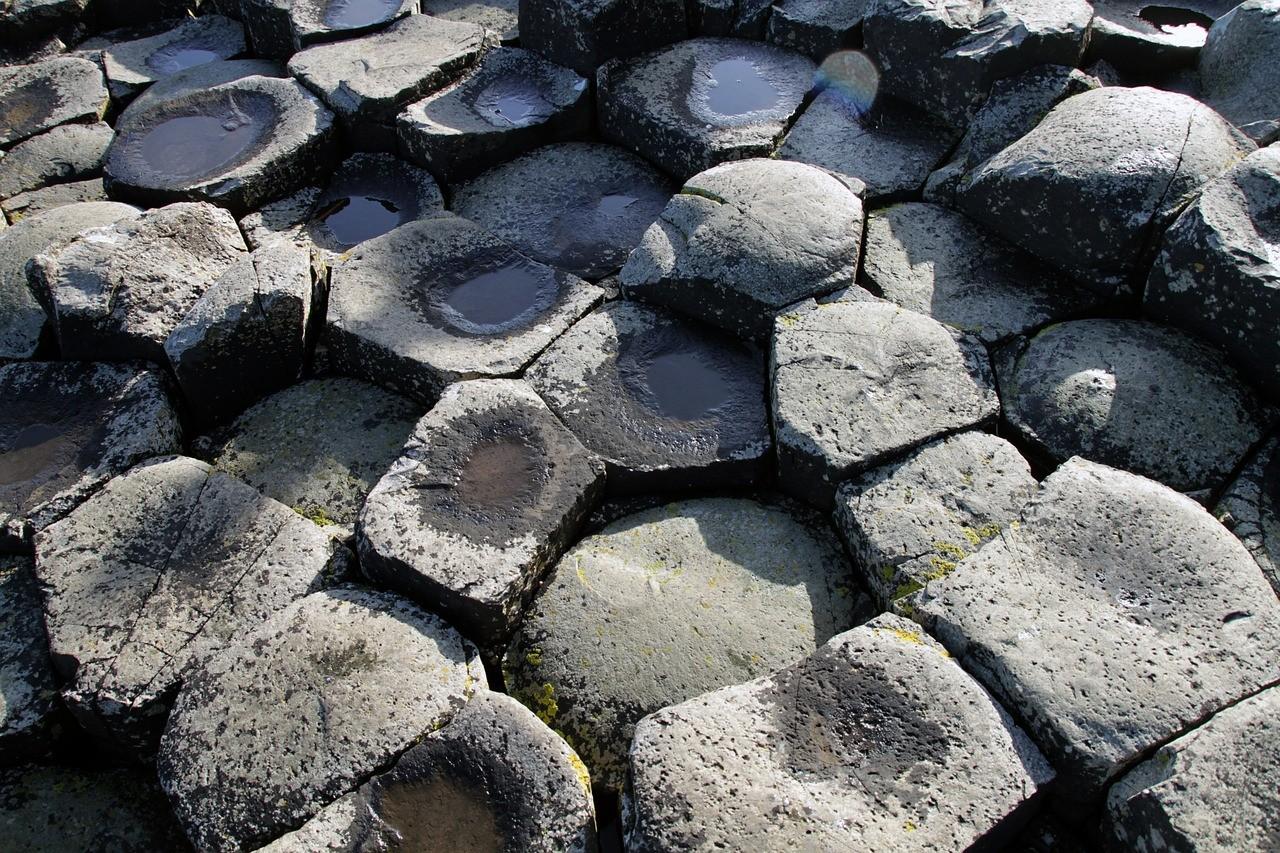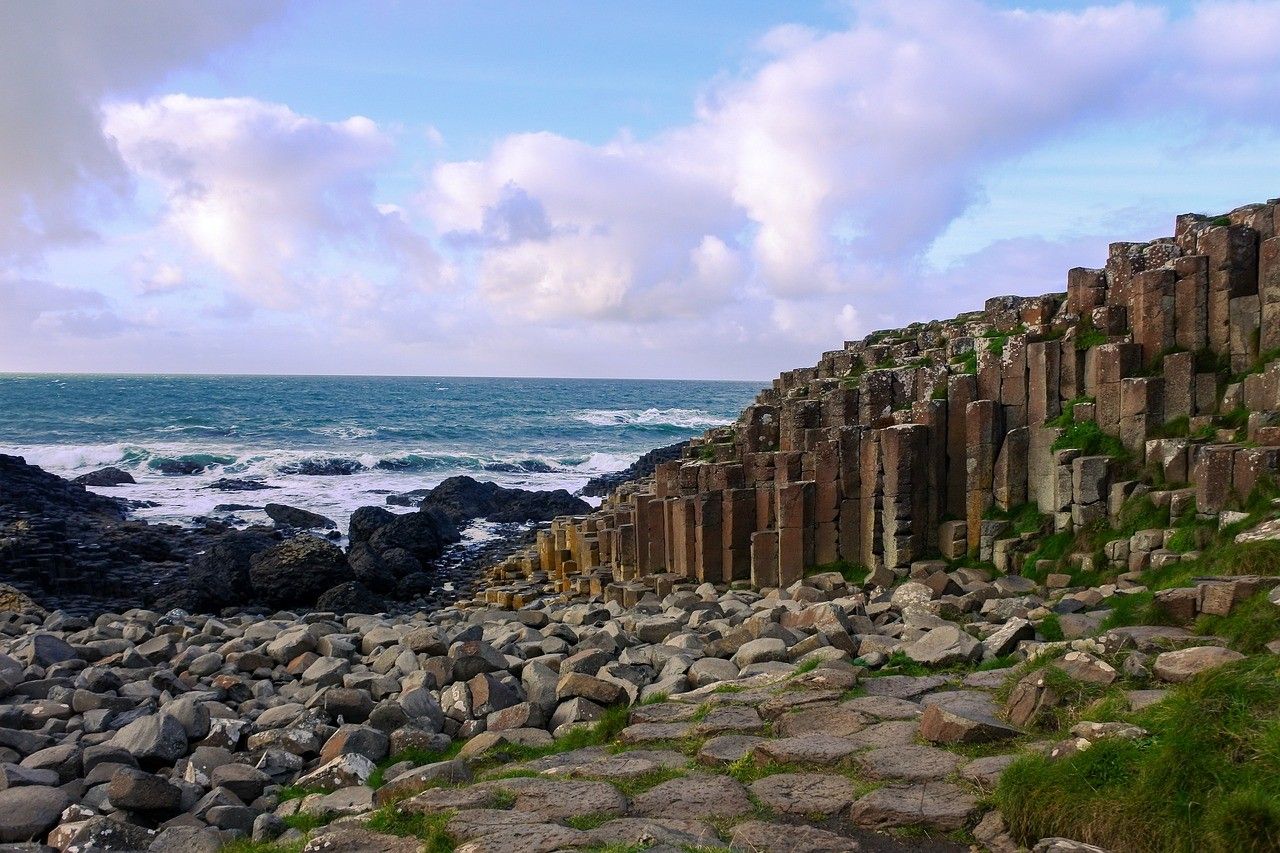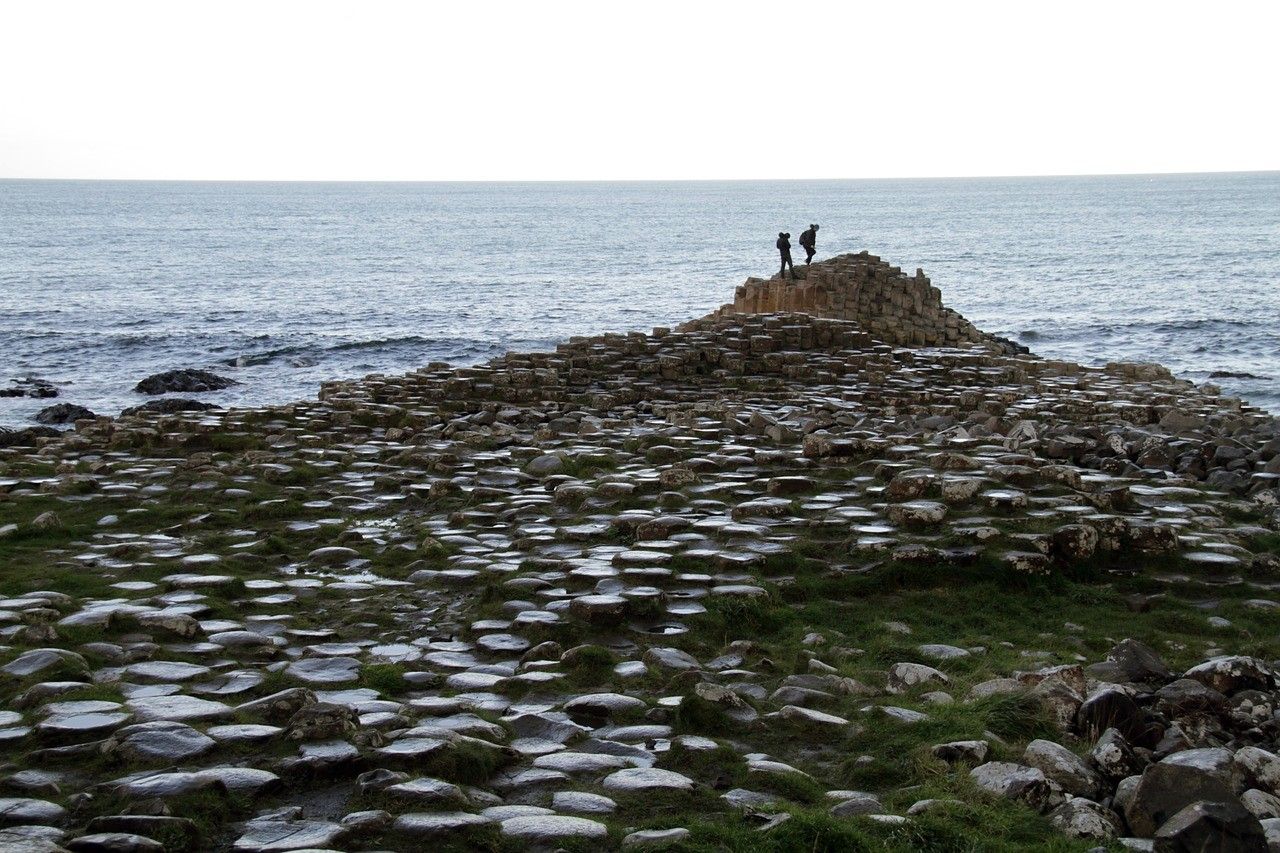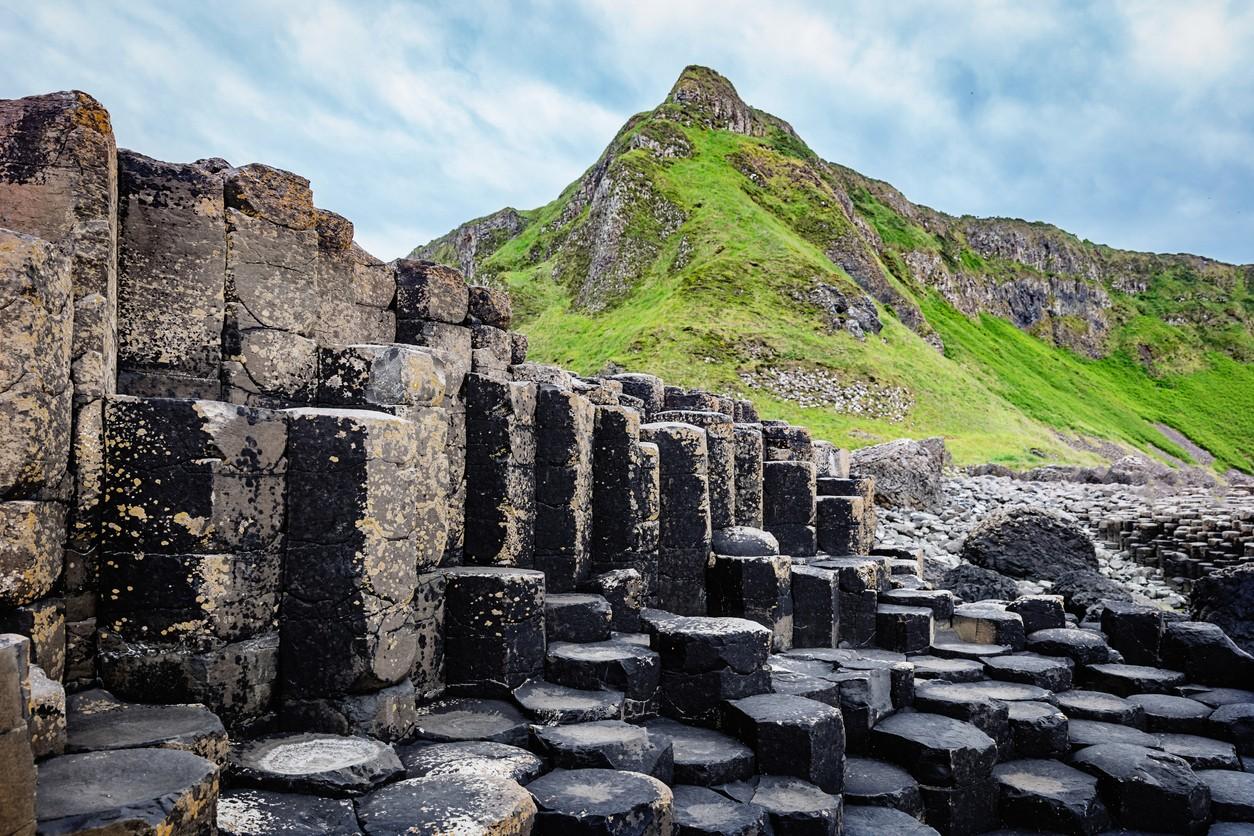The Giant's Causeway is a breathtaking natural wonder located on the north coast of County Antrim in Northern Ireland. This UNESCO World Heritage Site is renowned for its stunning geological features, consisting of roughly 40,000 interlocking basalt columns that were formed by ancient volcanic activity. The Giant's Causeway has captured the imagination of visitors for centuries, with its unique appearance and fascinating mythology. The Giant's Causeway is situated near the town of Bushmills, approximately 60 miles northwest of Belfast. Its location along the rugged coastline adds to its allure, as visitors can take in the awe-inspiring views of the Atlantic Ocean while exploring the site. The area surrounding the Giant's Causeway is also home to several other natural wonders, such as the Carrick-a-Rede Rope Bridge and the picturesque Dunluce Castle. Visitors to the Giant's Causeway can enjoy a range of activities, from hiking along the coastal paths to learning about the site's geology and mythology at the state-of-the-art visitor centre. The visitor centre offers audio guides, interactive exhibits, and a café where you can relax and take in the stunning views. Giant's Causeway tickets can be purchased online or at the visitor centre, with various options available depending on your interests and budget.
Geological Formation of the Giant's Causeway
The Giant's Causeway's geological story is a fascinating tale that spans over 60 million years. During the Paleocene epoch, the region was a hotbed of volcanic activity, with molten basalt lava erupting through chalk beds and forming an extensive lava plateau. As the lava cooled and contracted, it underwent a process called columnar jointing, which resulted in the formation of the iconic hexagonal columns we see today. The process of columnar jointing is a remarkable example of nature's symmetry and precision. As the lava cooled, it contracted and cracked in a perpendicular direction to the cooling surface, creating long, straight columns. The hexagonal shape of the columns is a result of the lava's even cooling rate and the natural tendency of cracks to form at 120-degree angles to each other, which is the most energy-efficient configuration. The size and shape of the columns at the Giant's Causeway vary depending on factors such as the lava flow's thickness, cooling rate, and the presence of impurities. Some columns are tall and slender, reaching heights of up to 12 meters (39 feet), while others are shorter and more stout. The columns are typically tightly packed and interlocking, creating a "stepping stone" appearance that stretches out into the sea.
Over millions of years, the forces of erosion have played a significant role in shaping the Giant's Causeway into its current form. The relentless waves of the Atlantic Ocean have gradually worn away the softer surrounding rock, exposing the more resistant basalt columns. This process has created a series of cliffs, bays, and rock formations that add to the site's rugged beauty and geological intrigue. One of the most remarkable features of the Giant's Causeway is the Amphitheatre, a sweeping arc of columns that resemble the seating in an ancient arena. This formation was created by the interaction of several lava flows, each cooling and fracturing at different rates and angles. The result is a staggering display of natural architecture that showcases the complex interplay of volcanic activity and erosion over millions of years. Other notable geological features at the Giant's Causeway include the Organ, a set of tall, organ pipe-like columns, and the Giant's Eyes, two large depressions in the rock that resemble a pair of eyes staring out to sea. These formations, along with countless others, offer visitors a glimpse into the Earth's ancient past and the powerful forces that have shaped our planet over millennia.
The Giant's Causeway's geological story is not only captivating but also scientifically significant. The site has been studied by geologists and earth scientists for centuries, providing valuable insights into volcanic processes, lava flow dynamics, and the effects of erosion on the landscape. Today, the Giant's Causeway remains a testament to the awe-inspiring power and beauty of the Earth's geological forces, inviting visitors to marvel at the wonders of our planet's natural history.
Mythology & Legends of the Giant's Causeway
The Giant's Causeway is not only a geological marvel but also a place steeped in rich mythology and captivating legends. The most famous of these tales involves the Irish giant Fionn mac Cumhaill (also known as Finn MacCool) and his epic battle with the Scottish giant Benandonner. According to legend, Fionn mac Cumhaill was a mighty warrior and leader of the Fianna, a legendary band of heroes in Irish mythology. He was known for his strength, bravery, and cunning, and his exploits were celebrated in countless stories and songs throughout Ireland.
The tale of the Giant's Causeway begins with Fionn mac Cumhaill's desire to challenge his rival, the Scottish giant Benandonner, to a battle. To reach Scotland, Fionn built a causeway of giant stepping stones across the North Channel, allowing him to cross the sea and confront his foe. When Fionn arrived in Scotland, he was shocked to discover that Benandonner was much larger and stronger than he had anticipated. Realising that he was outmatched, Fionn retreated to Ireland, tearing up the causeway behind him to prevent Benandonner from following. However, Benandonner was not so easily deterred. He pursued Fionn across the sea, determined to finish their battle once and for all. When he arrived in Ireland, Fionn's quick-thinking wife, Oonagh, came up with a clever plan to protect her husband. Oonagh disguised Fionn as a baby and placed him in a giant cradle. When Benandonner arrived at their home, he was astonished by the size of the "baby" and assumed that its father, Fionn, must be a giant among giants. Terrified by the thought of facing such a colossal opponent, Benandonner fled back to Scotland, destroying the remainder of the causeway as he went to ensure that Fionn could not follow him.
This enchanting tale has captured the imaginations of people for generations, weaving together elements of mythology, folklore, and the natural landscape. The story of Fionn Mac Cumhaill and Benandonner has become an integral part of the Giant's Causeway's cultural heritage, adding a layer of magic and mystery to this already awe-inspiring site. Visitors to the Giant's Causeway can immerse themselves in the legend of the battling giants by exploring the various rock formations that bear their names. The Giant's Boot, a large rock formation that resembles a giant's footprint, is said to be a remnant of Benandonner's hasty retreat back to Scotland. Similarly, the Wishing Chair, a natural throne formed by perfectly arranged basalt columns, is believed to grant wishes to those who sit upon it.
The mythology surrounding the Giant's Causeway is not limited to the tale of Fionn mac Cumhaill and Benandonner. Other legends speak of the causeway as a gateway to the mythical island of Tír na nÓg, the land of eternal youth in Irish folklore. Some stories even suggest that the causeway was built by the ancient Irish god Lugh, who used it to cross the sea and battle the Formorians, a race of supernatural beings. These myths and legends add a rich tapestry of storytelling to the Giant's Causeway, inviting visitors to engage with the site's cultural history and let their imaginations run wild. The visitor centre offers a variety of exhibits and interactive displays that delve into the mythology of the causeway, bringing these ancient tales to life for modern audiences.
Visiting the Giant's Causeway
A visit to the Giant's Causeway is an unforgettable experience that combines natural beauty, geological wonder, and rich cultural heritage. Located on the stunning north coast of County Antrim in Northern Ireland, this UNESCO World Heritage Site attracts visitors from around the globe who come to marvel at its unique basalt columns and breathtaking coastal scenery. The journey to the Giant's Causeway is an adventure in itself, with winding roads that offer glimpses of the rugged coastline and rolling green hills of the surrounding countryside. Visitors can choose to drive or take public transportation, with regular bus services running from nearby towns such as Belfast and Bushmills.
Upon arriving at the Giant's Causeway visitor centre, guests are greeted by a state-of-the-art facility that offers a range of amenities and services. The visitor centre features interactive exhibits, audio guides, and informative displays that delve into the geological formation and mythological significance of the causeway. Visitors can purchase their Giant's Causeway tickets here, with various options available to suit different interests and budgets. After exploring the visitor centre, guests can embark on the short walk down to the Giant's Causeway itself. The path is well-maintained and suitable for visitors of all ages and abilities, with benches and viewing points along the way that offer stunning vistas of the coastline and the causeway's distinctive basalt columns.
Visitors are free to wander among the columns, marvelling at their perfect symmetry and intricate patterns. The tallest columns reach heights of up to 12 meters (39 feet), while the shortest is just a few centimetres tall. Some of the most famous features of the Giant's Causeway include the Wishing Chair, a natural throne formed by perfectly arranged columns, and the Giant's Boot, a large rock formation that resembles a giant's footprint.
Several hiking trails wind along the coastal cliffs, offering breathtaking views of the Giant's Causeway and the surrounding landscape. The Red Trail is a popular option, taking visitors on a scenic route past the Amphitheatre, a sweeping arc of columns that resemble the seating in an ancient arena, and the Shepherd's Steps, a steep staircase that leads down to the sea. Along the way, visitors can spot a variety of wildlife, including seabirds, wildflowers, and even the occasional seal or dolphin in the waters below. The Giant's Causeway is also home to several rare plant species, such as the fringed sandwort and the sea spleenwort, which thrive in the unique microclimate created by the basalt columns. After exploring the causeway and its surrounding trails, visitors can return to the visitor centre to relax and refuel at the café, which offers a range of locally sourced food and drink options. The café's large windows provide stunning views of the coastline, making it the perfect spot to sit back and reflect on the day's adventures.
For those who want to delve deeper into the Giant's Causeway's mythology and legends, the visitor centre offers a variety of storytelling sessions and guided tours that bring these ancient tales to life. Visitors can learn about the legendary battle between the Irish giant Fionn mac Cumhaill and his Scottish rival Benandonner, or explore the site's connections to other mythical places in Irish folklore. As the day draws to a close, visitors can take one last look at the Giant's Causeway, watching as the setting sun casts a warm glow over the basalt columns and the rolling waves of the Atlantic Ocean. It's a moment of pure magic, one that captures the timeless beauty and enduring allure of this incredible place.
Accommodations Nearby
For visitors looking to stay near the Giant's Causeway, there are several accommodation options available in the surrounding area. These range from hotels and inns to guest houses and self-catering properties, catering to various budgets and preferences. Some of the most popular establishments include:
Causeway Hotel — Located just a stone's throw from the Giant's Causeway, this historic hotel offers 28 en-suite rooms with stunning views of the Atlantic Ocean or private terraces. The hotel features a bar lounge, a restaurant serving locally sourced produce, and facilities for weddings and conferences.
The Bushmills Inn Hotel — Situated in the nearby town of Bushmills, this award-winning hotel combines traditional charm with modern amenities. The hotel offers luxurious rooms, a restaurant serving fine Irish cuisine, and a cosy gas-lit bar.
Bayview Hotel — Overlooking the picturesque Portballintrae Bay, this family-run hotel offers comfortable rooms, a restaurant, and a bar. The hotel is just a short drive from the Giant's Causeway and other nearby attractions.
Adelphi Portrush — Located in the seaside town of Portrush, this hotel offers modern rooms, a restaurant, and a bar. The hotel is just a short drive from the Giant's Causeway and is an ideal base for exploring the Causeway Coastal Route.
Inn on the Coast — Situated between Portrush and Portstewart, this inn offers comfortable rooms, a restaurant, and a bar. The inn is just a short drive from the Giant's Causeway and other nearby attractions.
Golflinks Hotel — Located in the heart of Portrush, this hotel offers modern rooms, a restaurant, and a bar. The hotel is just a short drive from the Giant's Causeway and is an ideal base for exploring the North Antrim coastline.
Carnside Guest House — Situated in the town of Portrush, this guest house offers comfortable rooms and a hearty breakfast. The guest house is just a short drive from the Giant's Causeway and other nearby attractions.
Finn McCools Giants Causeway Hostel — Located in the village of Bushmills, this hostel offers budget-friendly accommodation in both dormitory-style and private rooms. The hostel is just a short drive from the Giant's Causeway and is an ideal base for exploring the surrounding area.
FAQs
Where is the Giant's Causeway?
The Giant's Causeway is located on the north coast of County Antrim in Northern Ireland, near the town of Bushmills. It is approximately 60 miles northwest of Belfast.
Is the Giant's Causeway in Scotland?
No, the Giant's Causeway is not located in Scotland. While the mythological story of the causeway involves a Scottish giant, the actual site is located in Northern Ireland.
How long does it take to visit the Giant's Causeway?
The amount of time you spend at the Giant's Causeway will depend on your interests and the activities you choose to do. Most visitors spend between 1-3 hours exploring the site, although those who embark on the longer hiking trails may spend half a day or more in the area.
Can you walk on the Giant's Causeway?
Yes, visitors are allowed and encouraged to walk on the Giant's Causeway. The basalt columns are sturdy and safe to walk on, although caution should be exercised in wet or windy conditions.
Are there guided tours available at the Giant's Causeway?
Yes, guided tours are available at tGiant's Causeway. These tours are led by knowledgeable guides who provide insights into the site's geology, history, and mythology. Tours can be booked in advance or on the day of your visit, depending on availability.
Is the Giant's Causeway accessible for people with disabilities?
The Giant's Causeway visitor centre is fully accessible for people with disabilities, with wheelchair access, accessible restrooms, and hearing loops. The path leading down to the causeway is also wheelchair accessible, although the uneven terrain of the basalt columns may be challenging for some visitors. The site offers a mobility scooter service for those who need assistance navigating the causeway.
Are there any nearby attractions to the Giant's Causeway?
Yes, there are several nearby attractions that visitors can explore in addition to tGiant's Causeway. These include the Carrick-a-Rede Rope Bridge, a thrilling suspension bridge that spans a 30-meter deep chasm; the Bushmills Distillery, the oldest licensed whiskey distillery in Ireland; and the picturesque ruins of Dunluce Castle, perched on a cliff edge overlooking the sea.
What is the best time of year to visit the Giant's Causeway?
Giant's Causeway is open year-round, and each season offers its unique charms. Summer is the busiest time of year, with long daylight hours and warmer temperatures. Spring and autumn offer milder weather and fewer crowds, making them ideal for hiking and exploring the coastal trails. Winter can be cold and wet, but the dramatic storms and crashing waves create a moody, atmospheric backdrop to the causeway's rugged beauty.
Are there any accommodations near the Giant's Causeway?
Yes, there is a range of accommodations available near Giant's Causeway to suit different budgets and preferences. These include bed and breakfasts, self-catering cottages, hotels, and hostels. The nearby towns of Bushmills and Portrush offer a variety of options, as well as restaurants, pubs, and shops.
Can you take photos at the Giant's Causeway?
Yes, photography is allowed and encouraged at Giant's Causeway. The site's unique geological features and stunning coastal scenery provide endless opportunities for memorable photos. However, visitors are asked to be respectful of the natural environment and other visitors when taking photos and to follow any guidelines or restrictions provided by the site's staff.
Related Articles

Let us know you agree to cookies
We use marketing, analytical and functional cookies as well as similar technologies to give you the best experience. Third parties, including social media platforms, often place tracking cookies on our site to show you personalised adverts outside of our website.
We store your cookie preferences for two years and you can edit your preferences via ‘manage cookies’ or through the cookie policy at the bottom of every page. For more information, please see our cookie policy.

